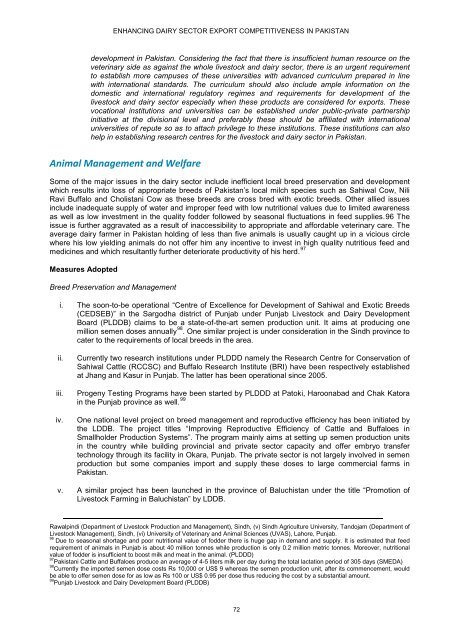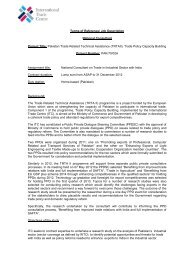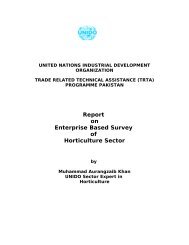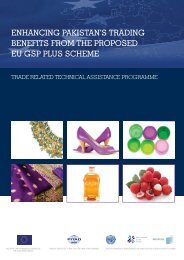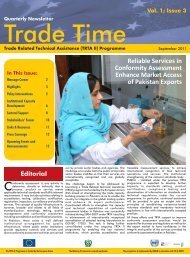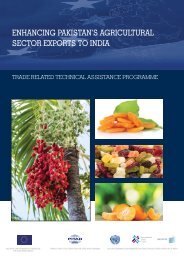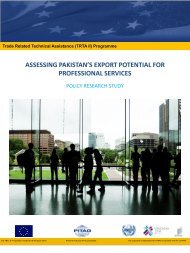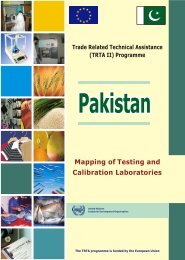Enhancing dairy sector export competitiveness - International Trade ...
Enhancing dairy sector export competitiveness - International Trade ...
Enhancing dairy sector export competitiveness - International Trade ...
You also want an ePaper? Increase the reach of your titles
YUMPU automatically turns print PDFs into web optimized ePapers that Google loves.
ENHANCING DAIRY SECTOR EXPORT COMPETITIVENESS IN PAKISTANdevelopment in Pakistan. Considering the fact that there is insufficient human resource on theveterinary side as against the whole livestock and <strong>dairy</strong> <strong>sector</strong>, there is an urgent requirementto establish more campuses of these universities with advanced curriculum prepared in linewith international standards. The curriculum should also include ample information on thedomestic and international regulatory regimes and requirements for development of thelivestock and <strong>dairy</strong> <strong>sector</strong> especially when these products are considered for <strong>export</strong>s. Thesevocational institutions and universities can be established under public-private partnershipinitiative at the divisional level and preferably these should be affiliated with internationaluniversities of repute so as to attach privilege to these institutions. These institutions can alsohelp in establishing research centres for the livestock and <strong>dairy</strong> <strong>sector</strong> in Pakistan.Animal Management and WelfareSome of the major issues in the <strong>dairy</strong> <strong>sector</strong> include inefficient local breed preservation and developmentwhich results into loss of appropriate breeds of Pakistan’s local milch species such as Sahiwal Cow, NiliRavi Buffalo and Cholistani Cow as these breeds are cross bred with exotic breeds. Other allied issuesinclude inadequate supply of water and improper feed with low nutritional values due to limited awarenessas well as low investment in the quality fodder followed by seasonal fluctuations in feed supplies.96 Theissue is further aggravated as a result of inaccessibility to appropriate and affordable veterinary care. Theaverage <strong>dairy</strong> farmer in Pakistan holding of less than five animals is usually caught up in a vicious circlewhere his low yielding animals do not offer him any incentive to invest in high quality nutritious feed andmedicines and which resultantly further deteriorate productivity of his herd. 97Measures AdoptedBreed Preservation and Managementi. The soon-to-be operational “Centre of Excellence for Development of Sahiwal and Exotic Breeds(CEDSEB)” in the Sargodha district of Punjab under Punjab Livestock and Dairy DevelopmentBoard (PLDDB) claims to be a state-of-the-art semen production unit. It aims at producing onemillion semen doses annually 98 . One similar project is under consideration in the Sindh province tocater to the requirements of local breeds in the area.ii.iii.iv.Currently two research institutions under PLDDD namely the Research Centre for Conservation ofSahiwal Cattle (RCCSC) and Buffalo Research Institute (BRI) have been respectively establishedat Jhang and Kasur in Punjab. The latter has been operational since 2005.Progeny Testing Programs have been started by PLDDD at Patoki, Haroonabad and Chak Katorain the Punjab province as well. 99One national level project on breed management and reproductive efficiency has been initiated bythe LDDB. The project titles “Improving Reproductive Efficiency of Cattle and Buffaloes inSmallholder Production Systems”. The program mainly aims at setting up semen production unitsin the country while building provincial and private <strong>sector</strong> capacity and offer embryo transfertechnology through its facility in Okara, Punjab. The private <strong>sector</strong> is not largely involved in semenproduction but some companies import and supply these doses to large commercial farms inPakistan.v. A similar project has been launched in the province of Baluchistan under the title “Promotion ofLivestock Farming in Baluchistan” by LDDB.Rawalpindi (Department of Livestock Production and Management), Sindh, (v) Sindh Agriculture University, Tandojam (Department ofLivestock Management), Sindh, (vi) University of Veterinary and Animal Sciences (UVAS), Lahore, Punjab.96Due to seasonal shortage and poor nutritional value of fodder there is huge gap in demand and supply. It is estimated that feedrequirement of animals in Punjab is about 40 million tonnes while production is only 0.2 million metric tonnes. Moreover, nutritionalvalue of fodder is insufficient to boost milk and meat in the animal. (PLDDD)97 Pakistani Cattle and Buffaloes produce an average of 4-5 liters milk per day during the total lactation period of 305 days (SMEDA)98 Currently the imported semen dose costs Rs 10,000 or US$ 9 whereas the semen production unit, after its commencement, wouldbe able to offer semen dose for as low as Rs 100 or US$ 0.95 per dose thus reducing the cost by a substantial amount.99 Punjab Livestock and Dairy Development Board (PLDDB)72


